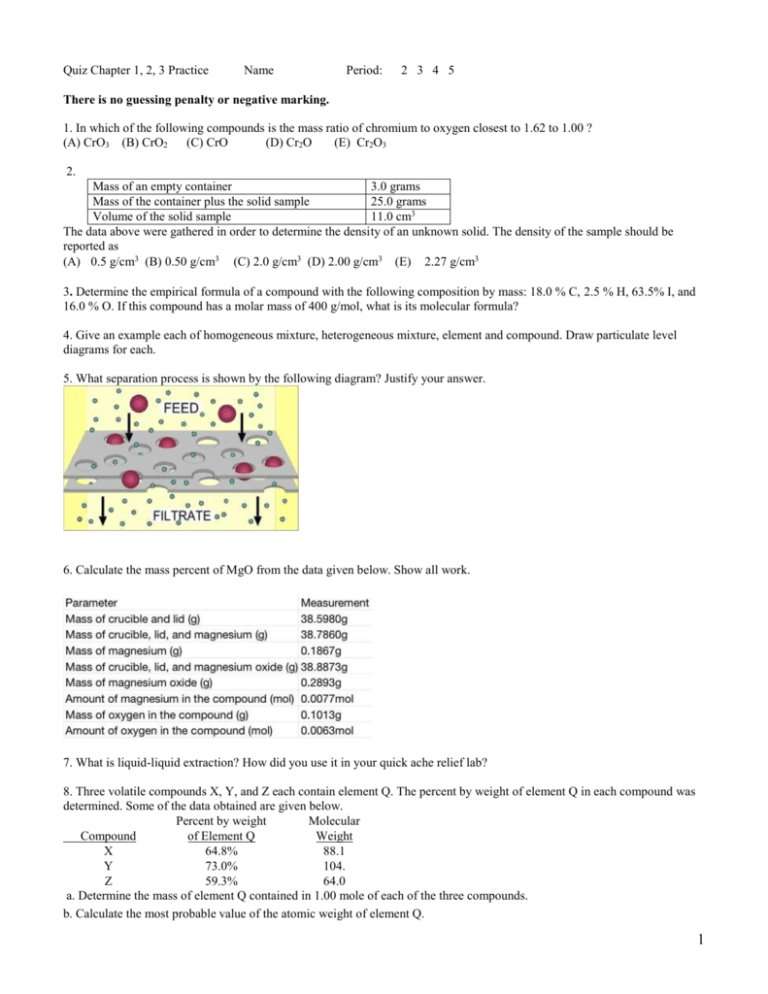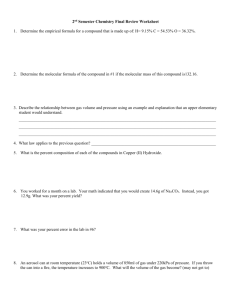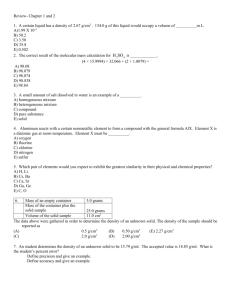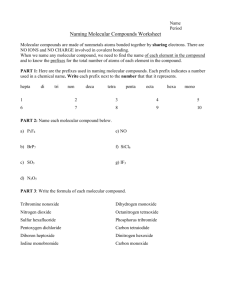Version 2013 - mvhs
advertisement

Quiz Chapter 1, 2, 3 Practice Name Period: 2 3 4 5 There is no guessing penalty or negative marking. 1. In which of the following compounds is the mass ratio of chromium to oxygen closest to 1.62 to 1.00 ? (A) CrO3 (B) CrO2 (C) CrO (D) Cr2O (E) Cr2O3 2. Mass of an empty container 3.0 grams Mass of the container plus the solid sample 25.0 grams Volume of the solid sample 11.0 cm3 The data above were gathered in order to determine the density of an unknown solid. The density of the sample should be reported as (A) 0.5 g/cm3 (B) 0.50 g/cm3 (C) 2.0 g/cm3 (D) 2.00 g/cm3 (E) 2.27 g/cm3 3. Determine the empirical formula of a compound with the following composition by mass: 18.0 % C, 2.5 % H, 63.5% I, and 16.0 % O. If this compound has a molar mass of 400 g/mol, what is its molecular formula? 4. Give an example each of homogeneous mixture, heterogeneous mixture, element and compound. Draw particulate level diagrams for each. 5. What separation process is shown by the following diagram? Justify your answer. 6. Calculate the mass percent of MgO from the data given below. Show all work. 7. What is liquid-liquid extraction? How did you use it in your quick ache relief lab? 8. Three volatile compounds X, Y, and Z each contain element Q. The percent by weight of element Q in each compound was determined. Some of the data obtained are given below. Percent by weight Molecular Compound of Element Q Weight X 64.8% 88.1 Y 73.0% 104. Z 59.3% 64.0 a. Determine the mass of element Q contained in 1.00 mole of each of the three compounds. b. Calculate the most probable value of the atomic weight of element Q. 1 c. Compound Z contains carbon, hydrogen, and element Q. When 1.00 gram of compound Z is oxidized and all of the carbon and hydrogen are converted to oxides, 1.37 grams of CO 2 and 0.281 gram of water are produced. Determine the most probable molecular formula of compound Z. 9. What mass of Au is produced when 0.0500 mol of Au 2S3 is reacted completely with excess H2 according to the following equation ? Au2S3 + 3 H2 2 Au + 3 H2S (A) 9.85 g (B) 19.7 g (C) 24.5 g (D) 39.4 g (E) 48.9 g 10. When a 1.00-gram sample of limestone was dissolved in acid, 0.38 gram of CO2 was generated. If the rock contained no carbonate other than CaCO3, what was the percent of CaCO3 by mass in the limestone? (A) 17% (B) 51% (C) 64% (D) 86% (E) 100% 11. Cyclohexene, a hydrocarbon, has a molar mass of 82.1 g/mole. If the combustion of 0.8300 g cyclohexene produces 0.9102 g H2O and 2.668 g CO2, what is the molecular formula of this compound? 2








